9 Out-of-This-World Moments For Space Communications & Navigation In 2023

9 Out-of-This-World Moments for Space Communications & Navigation in 2023
How do astronauts and spacecraft communicate with Earth?
By using relay satellites and giant antennas around the globe! These tools are crucial to NASA’s space communications networks: the Near Space Network and the Deep Space Network, which bring back science and exploration data every day.
It’s been a great year for our space communications and navigation community, who work to maintain the networks and enhance NASA’s capabilities. Keep scrolling to learn more about our top nine moments.

The SpaceX Falcon 9 rocket carrying the Dragon spacecraft lifts off from Launch Complex 39A at NASA's Kennedy Space Center in Florida on Thursday, Nov. 9, 2023, on the company's 29th commercial resupply services mission for the agency to the International Space Station. Liftoff was at 8:28 p.m. EST.
1. In November, we launched a laser communications payload, known as ILLUMA-T, to the International Space Station. Now, ILLUMA-T and the Laser Communications Relay Demonstration (LCRD) are exchanging data and officially complete NASA’s first two-way, end-to-end laser relay system. Laser communications can send more data at once than traditional radio wave systems – think upgrading from dial-up to fiber optic internet. ILLUMA-T and LCRD are chatting at 1.2 gigabits per second (Gbps). At that rate, you could download an average movie in under a minute.

NASA’s InSight lander captured this selfie on Mars on April 24, 2022, the 1,211th Martian day, or sol, of the mission.
2. Data analyzed in 2023 from NASA’s retired InSight Mars lander provided new details about how fast the Red Planet rotates and how much it wobbles. Scientists leveraged InSight’s advanced radio technology, upgrades to the Deep Space Network, and radio signals to determine that Mars’ spin rate is increasing, while making the most precise measurements ever of Mars’ rotation.

TBIRD is demonstrating a direct-to-Earth laser communications link from low Earth orbit to a ground station on Earth.
3. We set a new high record! The TeraByte InfraRed Delivery (TBIRD) payload – also demonstrating laser communications like ILLUMA-T and LCRD – downlinked 4.8 terabytes of data at 200 Gbps in a single 5-minute pass. This is the highest data rate ever achieved by laser communications technology. To put it in perspective a single terabyte is the equivalent of about 500 hours of high-definition video.

A 34-meter (112-foot) wide antenna at Canberra Deep Space Communications Complex near Canberra, Australia.
4. This year we celebrated the Deep Space Network’s 60th anniversary. This international array of antennas located at three complexes in California, Spain, and Australia allow us to communicate with spacecraft at the Moon and beyond. Learn more about the Deep Space Network’s legacy and future advancements.

An illustration of the LunaNet architecture. LunaNet will bring internet-like services to the Moon.
5. We are bringing humans to the Moon with Artemis missions. During expeditions, astronauts exploring the surface are going to need internet-like capabilities to talk to mission control, understand their routes, and ensure overall safety. The space comm and nav group is working with international partners and commercial companies to develop LunaNet, and in 2023, the team released Draft LunaNet Specification Version 5, furthering development.

The High-Rate Delay Tolerant Networking node launched to the International Space Station in November and will act as a high-speed path for data.
6. In addition to laser communications, ILLUMA-T on the International Space Station is also demonstrating high-rate delay/disruption tolerant networking (HDTN). The networking node is showcasing a high-speed data path and a store-and-forward technique. HDTN ensures data reaches its final destination and isn’t lost on its path due to a disruption or delay, which are frequent in the space environment.

The Communications Services Project (CSP) partners with commercial industry to provide networking options for future spaceflight missions.
7. The space comm and nav team is embracing the growing aerospace industry by partnering with commercial companies to provide multiple networking options for science and exploration missions. Throughout 2023, our commercialization groups engaged with over 110 companies through events, one-on-one meetings, forums, conferences, and more. Over the next decade, NASA plans to transition near-Earth services from government assets to commercial infrastructure.

Middle and high school students solve a coding experiment during NASA's Office of STEM Engagement App Development Challenge.
8. Every year, NASA’s Office of STEM Engagement sponsors the App Development Challenge, wherein middle and high school students must solve a coding challenge. This year, student groups coded an application to visualize the Moon’s South Pole region and display information for navigating the Moon’s surface. Our space communications and navigation experts judged and interviewed students about their projects and the top teams visited NASA’s Johnson Space Center in Houston!

A SpaceX Falcon 9 rocket soars upward after liftoff at the pad at 3:27 a.m. EDT on Saturday, Aug. 26, from Kennedy Space Center’s Launch Complex 39A in Florida carrying NASA’s SpaceX Crew-7 crew members to the International Space Station. Aboard SpaceX’s Dragon spacecraft are NASA astronaut Jasmin Moghbeli, ESA (European Space Agency) astronaut Andreas Mogensen, JAXA (Japan Aerospace Exploration Agency) astronaut Satoshi Furukawa, and Roscosmos cosmonaut Konstantin Borisov.
9. The Near Space Network supported 19 launches in 2023! Launches included Commercial Crew flights to the International Space Station, science mission launches like XRISM and the SuperBIT balloon, and many more. Once in orbit, these satellites use Near Space Network antennas and relays to send their critical data to Earth. In 2023, the Near Space Network provided over 10 million minutes of communications support to missions in space.
Here’s to another year connecting Earth and space.
Make sure to follow us on Tumblr for your regular dose of space!
More Posts from Nasa and Others
🔎 Lava Lake Discovery
🌋 Raikoke Volcano Eruption
🔥 Uptick in Amazon Fire Activity
2019 brought many memorable events on Planet Earth, and NASA satellites and astronauts captured a lot of the action! From new discoveries to tracking natural events and capturing amazing scenery, here are a few highlights from around the globe.
Read more about the images in this video, here.
What’s Up - June 2018
What’s Up For June?
Jupiter and Venus at sunset, Mars, Saturn and Vesta until dawn.

First up is Venus. It reaches its highest sunset altitude for the year this month and sets more than two hours after sunset.

You can't miss Jupiter, only a month after its opposition--when Earth was directly between Jupiter and the Sun.

The best time to observe Jupiter through a telescope is 10:30 p.m. at the beginning of the month and as soon as it's dark by the end of the month.

Just aim your binoculars at the bright planet for a view including the four Galilean moons. Or just enjoy Jupiter with your unaided eye!

Saturn is at opposition June 27th, when it and the Sun are on opposite sides of Earth. It rises at sunset and sets at sunrise. Great Saturn viewing will last several more months. The best views this month will be just after midnight.

All year, the rings have been tilted wide open--almost 26 degrees wide this month--giving us a great view of Saturn's distinctive rings.

The tilt offers us a view of the north polar region, so exquisitely imaged by the Cassini spacecraft.

Near Saturn, the brightest asteroid--Vesta--is so bright that it can be seen with your unaided eye. It will be visible for several months.

A detailed star chart will help you pick out the asteroid from the stars. The summer Milky way provides a glittery backdrop.

Finally, Mars grows dramatically in brightness and size this month and is visible by 10:30 p.m. by month end.

The best views are in the early morning hours. Earth's closest approach with Mars is only a month away. It's the closest Mars has been to us since 2003.

Watch the full What’s Up for June Video:
There are so many sights to see in the sky. To stay informed, subscribe to our What’s Up video series on Facebook. Make sure to follow us on Tumblr for your regular dose of space: http://nasa.tumblr.com.

http://bit.ly/rawcuriosity
Take a look around Mars. Here’s where I’m working right now.
Click the link to see all my latest pictures from the surface of Mars.
10 “Out of This World" Facts About the James Webb Space Telescope
Wouldn’t it be neat to see a period of the universe’s history that we’ve never seen before? That’s exactly what the James Webb Space Telescope (JWST) will be able to do…plus more!
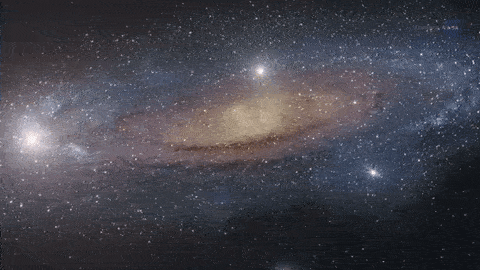
Specifically, Webb will see the first objects that formed as the universe cooled down after the Big Bang. We don’t know exactly when the universe made the first stars and galaxies – or how for that matter. That is what we are building Webb to help answer.
Here are 10 awesome facts about this next generation space telescope:
1. The James Webb Space Telescope is the world’s largest and next premier space observatory. It will extend the discoveries of the Hubble Space telescope and observe the birthplaces of stars, galaxies, planets and life over billions of years.

2. It is named after James Webb, NASA’s second administrator and champion of our science.

3. At 3 stories high and the size of a tennis court, it will be 100 times more powerful than Hubble!

4. It is so big that it has to fold origami-style to fit in the rocket, which is only 5.4 meters wide...And then it will unfurl, segment by segment, once in space.

5. The telescope will observe infrared light with unprecedented sensitivity. It will see the first galaxies born after the Big Bang over 13.5 billion years ago.

6. Webb's infrared cameras are so sensitive they must be shielded from light from the sun, Earth, and moon. The 5-layer sunshield is like having sunblock of SPF 1 million.

7. Webb will orbit the sun 1 million miles from Earth, where the telescope will operate at temperatures below -390 F (-235 C).

8. Webb’s mirrors are coated with a super thin layer of gold only about 1000 atoms thick to optimize their reflectivity in the infrared.

9. Webb will launch from French Guiana in 2018. It is launched near the equator because the faster spin of Earth there gives the rocket an extra push.

10. Webb is an international mission, with contributions from the European Space Agency and Canadian Space Agency. Once operational, scientists from all over the world will be able to use Webb to explore our solar system, planets outside our solar system, stars and galaxies.

Make sure to follow us on Tumblr for your regular dose of space: http://nasa.tumblr.com
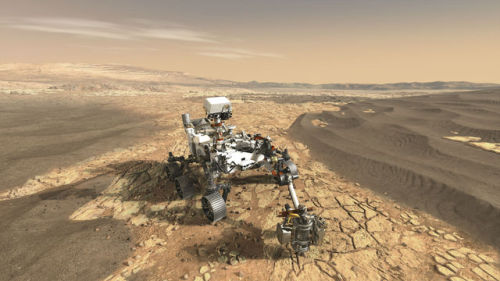
Our future Mars 2020 rover, seen here as imagined through the eyes of an artist, will search for signs of past microbial life. The mission will take the next step in exploring the Red Planet by not only seeking signs of habitable conditions on Mars in the ancient past, but also searching for signs of past microbial life itself.
The Mars 2020 rover introduces a drill that can collect core samples of the most promising rocks and soils and set them aside on the surface of Mars. A future mission could potentially return these samples to Earth. Mars 2020 is targeted for launch in July/August 2020, aboard an Atlas V 541 rocket from Space Launch Complex 41 at Cape Canaveral Air Force Station in Florida. Learn more.
Make sure to follow us on Tumblr for your regular dose of space: http://nasa.tumblr.com
What Science is Launching to Space?

The tenth SpaceX cargo resupply mission launched to the International Space Station on Feb. 18, and is carrying science ranging from protein crystal growth studies to Earth science payloads. Here’s a rundown of some of the highlights heading to the orbiting laboratory.

The CASIS PCG 5 investigation will crystallize a human monoclonal antibody, developed by Merck Research Labs, that is currently undergoing clinical trials for the treatment of immunological disease. Results from this investigation have the potential to improve the way monoclonal antibody treatments are administered on Earth.

Without proteins, the human body would be unable to repair, regulate or protect itself. Crystallizing proteins provides better views of their structure, which helps scientists to better understand how they function. Often times, proteins crystallized in microgravity are of higher quality than those crystallized on Earth. LMM Biophysics 1 explores that phenomena by examining the movement of single protein molecules in microgravity. Once scientists understand how these proteins function, they can be used to design new drugs that interact with the protein in specific ways and fight disease.

Much like LMM Biophysics 1, LMM Biophysics 3 aims to use crystallography to examine molecules that are too small to be seen under a microscope, in order to best predict what types of drugs will interact best with certain kinds of proteins. LMM Biophysics 3 will look specifically into which types of crystals thrive and benefit from growth in microgravity, where Earth’s gravity won’t interfere with their formation. Currently, the success rate is poor for crystals grown even in the best of laboratories. High quality, space-grown crystals could improve research for a wide range of diseases, as well as microgravity-related problems such as radiation damage, bone loss and muscle atrophy.


Nanobiosym Predictive Pathogen Mutation Study (Nanobiosym Genes) will analyze two strains of bacterial mutations aboard the station, providing data that may be helpful in refining models of drug resistance and support the development of better medicines to counteract the resistant strains.

During the Microgravity Expanded Stem Cells investigation, crew members will observe cell growth and morphological characteristics in microgravity and analyze gene expression profiles of cells grown on the station. This information will provide insight into how human cancers start and spread, which aids in the development of prevention and treatment plans. Results from this investigation could lead to the treatment of disease and injury in space, as well as provide a way to improve stem cell production for human therapy on Earth.

The Lightning Imaging Sensor will measure the amount, rate and energy of lightning as it strikes around the world. Understanding the processes that cause lightning and the connections between lightning and subsequent severe weather events is a key to improving weather predictions and saving life and property.

From the vantage of the station, the LIS instrument will sample lightning over a wider geographical area than any previous sensor.

Future robotic spacecraft will need advanced autopilot systems to help them safely navigate and rendezvous with other objects, as they will be operating thousands of miles from Earth.

The Raven (STP-H5 Raven) studies a real-time spacecraft navigation system that provides the eyes and intelligence to see a target and steer toward it safely. Research from Raven can be applied toward unmanned vehicles both on Earth and in space, including potential use for systems in NASA’s future human deep space exploration.

SAGE III will measure stratospheric ozone, aerosols, and other trace gases by locking onto the sun or moon and scanning a thin profile of Earth’s atmosphere.

These measurements will allow national and international leaders to make informed policy decisions regarding the protection and preservation of Earth’s ozone layer. Ozone in the atmosphere protects Earth’s inhabitants, including humans, plants and animals, from harmful radiation from the sun, which can cause long-term problems such as cataracts, cancer and reduced crop yield.

Tissue Regeneration-Bone Defect (Rodent Research-4) a U.S. National Laboratory investigation sponsored by the Center for the Advancement of Science in Space (CASIS) and the U.S. Army Medical Research and Materiel Command, studies what prevents other vertebrates such as rodents and humans from re-growing lost bone and tissue, and how microgravity conditions impact the process.

Results will provide a new understanding of the biological reasons behind a human’s inability to grow a lost limb at the wound site, and could lead to new treatment options for the more than 30% of the patient.
Make sure to follow us on Tumblr for your regular dose of space: http://nasa.tumblr.com
President Obama Calls the International Space Station
President Obama made a special phone call today - all the way to the International Space Station. During his chat, American astronauts Scott Kelly and Kjell Lindgren highlighted some important things we’re doing here at NASA:
One Year Mission

Astronaut Scott Kelly is a little over halfway through his One-Year Mission, and the President wanted to know how he was doing. Kelly’s year in space is providing essential research on our journey to Mars. The studies performed throughout his time on the space station will give us new insights to how the human body adjusts to weightlessness, isolation, radiation and stress during long duration spaceflight.
Adjusting to Microgravity... Like Riding a Bike?

During the call, the President asked Kelly if anything has surprised him while he’s been in space. Kelly responded and told him that he was surprised at how easily he remembered and adapted to microgravity from his previous missions. The President remarked, “So being an astronaut is like riding a bicycle?”
In space, there is no “up” or “down.” That can mess with the human brain and affect the way people move and think in space. An investigation on the International Space Station seeks to understand how the brain changes in space and ways to deal with those changes.
Research on the International Space Station

November marks the 15 years of continuous human presence on the International Space Station! During the call, the President pointed out that many of today’s children have never known a time when we didn’t have astronauts living aboard the International Space Station. Pretty amazing! There are currently more than 400 experiments on the station that will not only help us achieve our goals in space, but will also benefit life on Earth.
Inspiring the Next Generation

President Obama made sure to tell Kelly and Lindgren that he was proud of the work they’re doing to inspire the next generation of astronauts. He even mentioned how Scott Kelly’s Instagram feed provides an amazing glimpse into life for would-be astronauts. This next generation will be the first humans to step foot on Mars.
Journey To Mars

President Obama highlighted the fact that he has tasked NASA with sending humans on a journey to Mars. He hopes to see the first humans walk on the Martian surface in his lifetime, and supports the work we’re doing to get there.
What dose it feel like being inside a space suit?
The suit weighs about 300 pounds. We are made neutrally buoyant in the pool, but over time we can become negatively buoyant. The suit can feel heavy, even the bearings can become stiff, so it can be difficult to operate in the suit. With practice and the help of a great spacewalk team, we can make a spacewalk look seamless.
7 Sports Astronauts Love Without Gravity (Including Football)
Astronauts onboard the International Space Station spend most of their time doing science, exercising and maintaining the station. But they still have time to shoot hoops and toss around a football.
From chess to soccer, there’s a zero-gravity spin to everything.
1. Baseball



Baseball: America’s favorite pastime. JAXA astronaut, Satoshi Furukawa shows us how microgravity makes it possible to be a one-man team. It would be a lot harder to hit home runs if the players could jump that high to catch the ball.
2. Chess
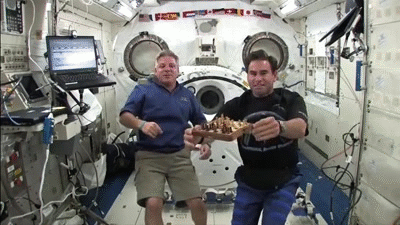
Yes, it’s a sport, and one time NASA astronaut Greg Chamitoff (right) played Earth on a Velcro chess board. An elementary school chess team would pick moves that everyone could vote for online. The winning move would be Earth’s play, and then Chamitoff would respond. About every two days, a move would be made. But who won the historic Earth vs. Space match? Earth! Chamitoff resigned after Earth turned its pawn into a queen, but it was game well played.
3. Soccer

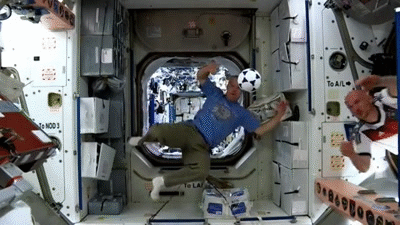
NASA astronaut Steve Swanson put a new spin on soccer by juggling the ball upside down. However, he might not have considered himself upside down. On the space station, up and down are relative.
4. Gymnastics
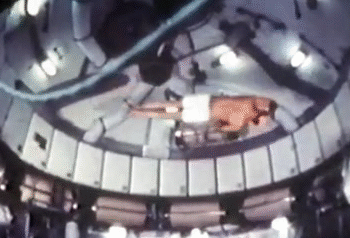
NASA astronauts usually sign off their videos with a zero-gravity somersault (either forwards or backwards). But astronauts are also proficient in handstands, flips and twists. The predecessor to the International Space Station, the Skylab, had the best space for the moves. The current space station is a bit tight in comparison.
5. Basketball

Objects that aren’t heavy don’t move very well on the space station. They kind of just float. It’s like Earth, but exaggerated. For example, on Earth a beach ball wouldn’t go as far as a basketball. The same is true in space, which is why playing with a basketball in space is more fun than playing with a beach ball.
6. Golf

People talk about hitting golf balls off skyscrapers, but what about off the International Space Station? While golf isn’t a normal occurrence on the station, it’s been there. One golf company even sent an experiment to the station to find out how to make better golf clubs.
7. Football

Zero gravity doesn’t make everything easier. Astronauts need to relearn how to throw things because their brains need to relearn how to interpret sensory information. A bowling ball on the space station no longer feels as heavy as a bowling ball on Earth. When astronauts first throw things on the space station, everything keeps going too high. That would put a wrench in your spiral for a couple of months. But once you adjust, the perfect spiral will just keep spiraling!
Make sure to follow us on Tumblr for your regular dose of space: http://nasa.tumblr.com
Asteroid Bennu, the Storyteller
Asteroids are the storytellers of our solar system’s youth. They are the closest we can get to the original material that makes up the sun, planets, and moons.
This week, our OSIRIS-REx spacecraft made history when it touched a pristine, ancient asteroid named Bennu to collect a sample from the surface. The intrepid spacecraft will now bring the asteroid sample – and its stories – back home to Earth.
Why is it that asteroid Bennu holds the history of our origins? Let’s go back to the beginning...

About 4.5 billion years ago, our solar system began as a spinning, swirling cloud made up of tiny bits of gaseous and rocky material. Most of that material – more than 99% of it – gathered in the center and went on to become the Sun.

The leftovers began to spin around the Sun, colliding into one another and forming larger and larger objects, eventually becoming planets, dwarf planets, and moons.

But asteroids didn't become part of planets or moons. So, while the material in planets and moons were superheated and altered during the formation of the solar system and weathered by geologic processes over time, asteroids remained pristine.

Each asteroid holds knowledge from that special time in our solar system’s history. Each one contains information about the chemicals, minerals, and molecules that were present when the solar system was just starting to form.

With missions like OSIRIS-REx, we are going on a journey to these ancient worlds, seeking to learn what they remember, seeking to expand our knowledge, and deepen our understanding of our origins.

Learn more about the OSIRIS-REx mission HERE, or follow the mission on Facebook, Twitter and Instagram.
Make sure to follow us on Tumblr for your regular dose of space: http://nasa.tumblr.com
-
 sonic-spade liked this · 2 weeks ago
sonic-spade liked this · 2 weeks ago -
 andy202405 liked this · 1 month ago
andy202405 liked this · 1 month ago -
 stuzzi liked this · 1 month ago
stuzzi liked this · 1 month ago -
 lovelyalicorn reblogged this · 2 months ago
lovelyalicorn reblogged this · 2 months ago -
 papawolf1969 liked this · 4 months ago
papawolf1969 liked this · 4 months ago -
 travelmanposts liked this · 5 months ago
travelmanposts liked this · 5 months ago -
 marcfreitx liked this · 5 months ago
marcfreitx liked this · 5 months ago -
 pixion liked this · 5 months ago
pixion liked this · 5 months ago -
 mintbecrazy liked this · 6 months ago
mintbecrazy liked this · 6 months ago -
 anamariaurrutia liked this · 8 months ago
anamariaurrutia liked this · 8 months ago -
 xftxr-world liked this · 8 months ago
xftxr-world liked this · 8 months ago -
 relativefict1on reblogged this · 9 months ago
relativefict1on reblogged this · 9 months ago -
 ottovonklott liked this · 9 months ago
ottovonklott liked this · 9 months ago -
 azuremallone liked this · 10 months ago
azuremallone liked this · 10 months ago -
 satellitetvcompany-blog liked this · 11 months ago
satellitetvcompany-blog liked this · 11 months ago -
 deadheadingcrew liked this · 11 months ago
deadheadingcrew liked this · 11 months ago -
 stillnotspamdog reblogged this · 11 months ago
stillnotspamdog reblogged this · 11 months ago -
 zhoujun88 liked this · 11 months ago
zhoujun88 liked this · 11 months ago -
 thecondemnedangelgabriel liked this · 11 months ago
thecondemnedangelgabriel liked this · 11 months ago -
 rodolfo9999 liked this · 1 year ago
rodolfo9999 liked this · 1 year ago -
 not-so-above-it-all liked this · 1 year ago
not-so-above-it-all liked this · 1 year ago -
 manessha545 liked this · 1 year ago
manessha545 liked this · 1 year ago -
 invadertomboy liked this · 1 year ago
invadertomboy liked this · 1 year ago -
 highimhope reblogged this · 1 year ago
highimhope reblogged this · 1 year ago -
 virtuosojo liked this · 1 year ago
virtuosojo liked this · 1 year ago -
 kai-etudie liked this · 1 year ago
kai-etudie liked this · 1 year ago -
 norzairies liked this · 1 year ago
norzairies liked this · 1 year ago -
 pit-stopz reblogged this · 1 year ago
pit-stopz reblogged this · 1 year ago -
 majestylokahisheena reblogged this · 1 year ago
majestylokahisheena reblogged this · 1 year ago -
 majestylokahisheena liked this · 1 year ago
majestylokahisheena liked this · 1 year ago -
 traveliv13 liked this · 1 year ago
traveliv13 liked this · 1 year ago -
 jazz-mine liked this · 1 year ago
jazz-mine liked this · 1 year ago -
 bluesunset1111 liked this · 1 year ago
bluesunset1111 liked this · 1 year ago -
 pipuisci reblogged this · 1 year ago
pipuisci reblogged this · 1 year ago -
 pipius liked this · 1 year ago
pipius liked this · 1 year ago -
 absolutesciencefiction reblogged this · 1 year ago
absolutesciencefiction reblogged this · 1 year ago -
 mithuraju liked this · 1 year ago
mithuraju liked this · 1 year ago -
 debbieb1124 liked this · 1 year ago
debbieb1124 liked this · 1 year ago -
 paprus-teutonic-knight liked this · 1 year ago
paprus-teutonic-knight liked this · 1 year ago
Explore the universe and discover our home planet with the official NASA Tumblr account
1K posts